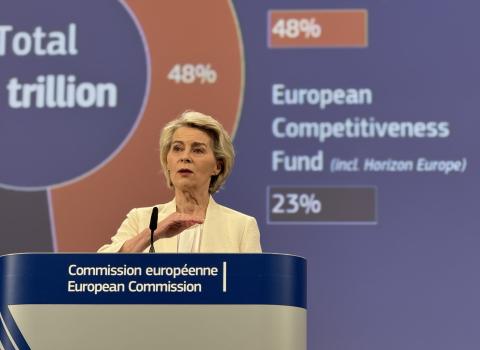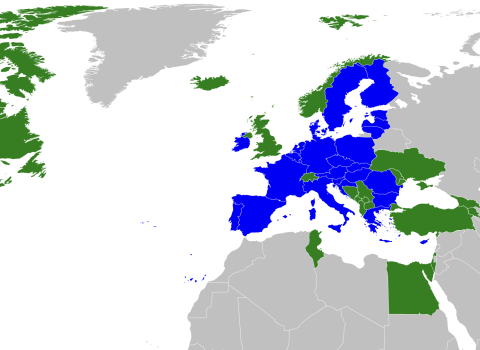Washington ‘welcomes’ change in EU grant template that, US universities say, could increase their involvement in Horizon Europe research projects

After years of bickering, Washington and Brussels appear to be patching up a disagreement over American researchers participating in the EU’s big R&D programmes. The result could be a rise in transatlantic science collaboration on climate, health and other urgent problems.
The surprise development – further evidence of how quickly US and EU science policies are converging as global challenges mount – started with an overture In July from the European Commission, which published a proposed grant template for its €95.5 billion Horizon Europe programme. The template included legal language that major US universities had been wanting for years, to make it easier for them to participate in the programme.
On 8 November, the White House praised the change in a statement responding to questions from Science|Business. “This is a welcome development,” said Cole Donovan, assistant director in the White House Office of Science and Technology Policy. It “will take some time” to analyse the new EU rules, he said, “but we are encouraged by the European Commission’s willingness to enact policies and procedures that deepen Transatlantic cooperation.”(See full statement.)
Some American and European universities have already started trying to figure out how it could affect their collaborations. As the contractual details are complex, it’s too early to predict the impact. But as one American university official put it, “our antennae are up.”
The seven-year, €95.5 billion Horizon Europe programme is unusual in international science funding for having a range of options to attract non-EU partners, from the US to Japan. But the details of how that works have been a frequent flash point – particularly with the US – in part because the idea of using taxpayer money to fund foreign research isn’t always welcomed by politicians on either side of the ocean. As a result, for the EU, the most common form of foreign collaboration takes place with countries that “associate” to Horizon Europe, paying money into the central EU pot so their researchers can bid directly for grants inside the EU system. But the US has never wanted to associate in that way, in part because Congress would never approve a foreign power deciding how US money gets spent.
Legal problems
So over the years, the EU devised several small work-arounds – some in which US researchers get paid, but most in which they don’t; instead, they bring their own US funding and can share in the European results. But this approach hit a snag when some US universities decided that the Commission’s standard grant terms might cause them legal problems at home. The Commission’s proposed new grant terms would side-step that, by making it explicit that third-country researchers that aren’t taking EU money don’t have to sign the standard grant agreement.
During the Trump administration, Brussels and Washington publicly traded barbs over the issue. But the change in government in Washington, and the start of a new seven-year EU programme, is thawing some of the transatlantic ice.
“Virginia Tech and a lot of other research universities are very interested in international collaboration,” said Karen DePauw, a recently retired vice president at that university. While she isn’t aware of any specific new deals in the works, “there are many faculty who would welcome the opportunity for themselves and their research programmes and their grad students to be more connected and collaborate” with European counterparts.
The template for how this could work is spelled out in a “pre-draft” version of an annotated model grant agreement published over the summer in Brussels. This annotated MGA, as it’s called, is the instruction manual for writing Horizon grant contracts, specifying in 188 pages everything from eligibility, accounting rules, and legal obligations. A final version was expected in September, but hasn’t materialised yet. “There are quite a lot of things still up in the air,” said Thomas Estermann, a director at the European Universities Association.
For US and other “third countries” the key part starts on page 99, and makes explicit for the first time that a non-EU researcher can participate in a Horizon project without having to sign the formal Commission grant agreement – on condition that they don’t take any EU money. That may sound like a lousy deal; and most American universities agree. Still, so strong are scientific ties across the ocean that even before the contractual change there had been 1,584 Horizon contract signings by Americans since 2014, mostl without EU funding. (For those who received EU funding in special circumstances, the total since 2014 was €129.6 million.) The appeal and importance of scientific collaboration was amply demonstrated last year, in the record-time development of COVID-19 vaccines, most of which involved researchers in the US and Europe.
For US universities, the new, no-sign provision in the contract is important: particularly at private universities, their lawyers have often been reluctant to sign off on deals that force them into having joint and several liability for anything that goes wrong in the grant, or submit to dispute resolution in a European court. The new grant language leaves details of that sort up to the US and European partners to arrange on their own – on condition that safeguards are agreed on eight possible problems, such as conflicts of interest or bad record-keeping. US university lawyers said these are fairly standard for them in their own US grants, and wouldn’t normally be an obstacle.
Possible subcontractors
So grants experts expect there will be a rise in these kind of unfunded US participations in Horizon. But the main prize for American universities would be widening the money spigot from Brussels. For that, there are potentially two other possibilities under discussion.
First is subcontracting. Some US academics have noted that the new model grant doesn’t explicitly preclude non-EU institutions from becoming subcontractors to a project – that is, getting paid for providing a specific service, like genetic analysis or help in clinical trials. But the Commission has yet to clarify its intention with this new language – and despite repeated requests for comment from Science|Business over five days, the Commission did not provide any answers. Until it does so, this avenue will remain untested.
Besides, says Maria-Valerie Schegk of the Technical University of Munich, it isn’t clear how often the European partners would want Americans as subcontracts. “It’s not so attractive to the European university; they have to share their budget” with the Americans, she said. “I don’t see this happening too often,” except in special cases when the Americans have an expertise the Europeans really need.
The second possibility is that, US and EU officials say, discussions are ongoing about more co-funding arrangements between Brussels and Washington. For this, on a common transatlantic research project, the various funding agencies would coordinate their work so their national researchers would get paid out of their familiar grant programmes – in essence, a transatlantic project in practice, if not on paper. That already happens in selected research areas, such as Atlantic Ocean and some health projects – but these discussions, if successful, would expand the number of opportunities.
Officials on both sides of the Atlantic say it will take some time for the impact of all this to be seen – and the White House statement suggests there is still some diplomacy ahead. As part of its own strategy to build “strategic autonomy” in key technologies, the Commission has said it plans to exclude third countries from late-stage R&D in sensitive areas like quantum and aerospace.
“We also hope the EU will take steps to re-open quantum and space programmes to partnerships with US scientists,” said the statement. “Every year, the US government provides millions of dollars of direct financial support to many of the leading labs in Europe to advance the field of quantum information science and technology in both fundamental and applied research.”
But the main US message was positive: “We are deeply committed to building back better the Transatlantic relationship, from basic research to cooperation on critical and emerging technologies. We would rather be first in discovery, together, than second or last, apart.”





 A unique international forum for public research organisations and companies to connect their external engagement with strategic interests around their R&D system.
A unique international forum for public research organisations and companies to connect their external engagement with strategic interests around their R&D system.